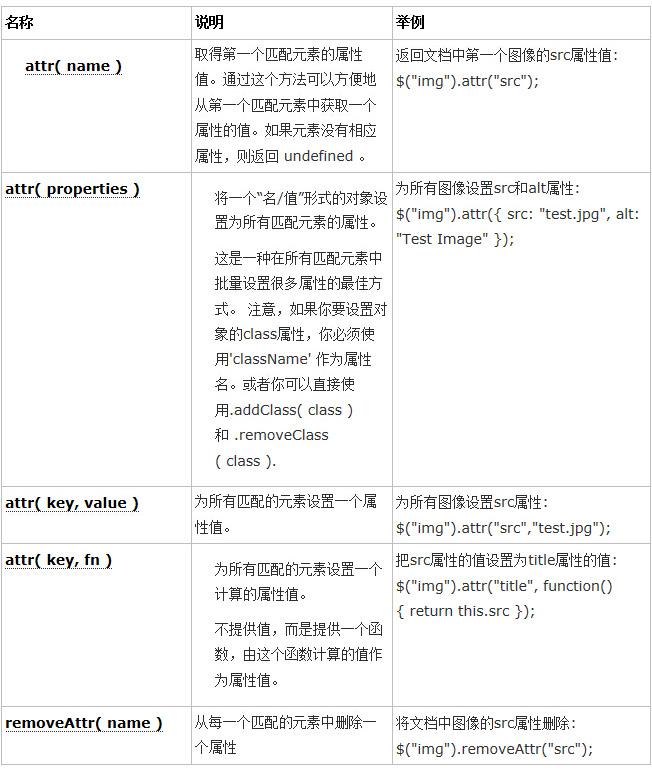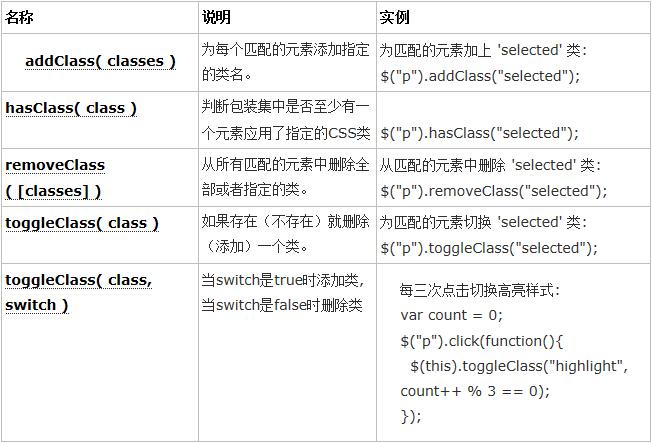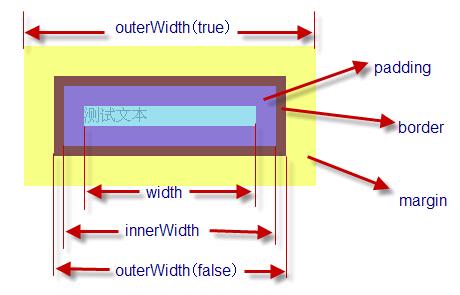 Web Front-end
Web Front-end
 JS Tutorial
JS Tutorial
 Detailed explanation of jQuery operation attributes and styles_jquery
Detailed explanation of jQuery operation attributes and styles_jquery
Detailed explanation of jQuery operation attributes and styles_jquery
• Distinguish between DOM attributes and element attributes
<img src="images/image.1.jpg" id="hibiscus" alt="Hibiscus" class="classA" />
Usually developers are accustomed to calling id, src, alt, etc. the "attributes" of this element. We call this "element attribute". However, when parsing into a DOM object, the actual browser will eventually parse the tag element into a "DOM object" and store the element's "element attributes" as "DOM attributes". There is a difference between the two.
Even some "element attributes" and "DOM attributes" have different names, such as the element attribute class above, which corresponds to className after being converted into a DOM attribute.
Keep in mind, in javascript we can directly get or set "DOM properties":
<script type="text/javascript">
$(function() {
var img1 = document.getElementById("hibiscus");
alert(img1.alt);
img1.alt = "Change the alt element attribute";
alert(img1.alt);
img1.className = "classB";
})
</script>So if you want to set the CSS style class of an element, you need to use the DOM attribute "className" instead of the element attribute "class".
-------------------------------------------------- ----------------------------------
•Operation "Dom attribute"
jQuery provides the each() function for traversing the jQuery packaging set, where the this pointer is a DOM object, so we can apply this with native javascript to operate the DOM attributes of the element:
$("img").each(function(index) {
alert("index:" + index + ", id:" + this.id + ", alt:" + this.alt);
this.alt = "changed";
alert("index:" + index + ", id:" + this.id + ", alt:" + this.alt);
});
•Operation "Element Attribute"
We can use getAttribute and setAttribute in javascript to operate the "element attributes" of the element. jQuery provides you with the attr() wrapping set function, which can simultaneously operate the attributes of all elements in the wrapping set:

Although we can use removeAttr(name) to delete element attributes, the corresponding DOM attributes will not be deleted, and will only affect the value of the DOM attribute. For example, removing the readonly element attribute of an input element will cause the corresponding The DOM attribute becomes false (that is, the input becomes editable).
• Modify CSS classes and styles
The following table is the jQuery methods related to modifying CSS classes:

Note that the parameters of addClass(class) and removeClass(classes) can be passed in multiple css classes at one time, separated by spaces. The parameters of the removeClass method are optional. If no parameters are passed in, all CSS classes will be removed.
Similarly, when we want to modify a specific CSS style of an element, that is, modify the element attribute "style", jQuery also provides the corresponding method:

• Get common attributes
<!doctype html>
<html lang="zh">
<head>
<meata charset="utf-8"/>
<title>get object width</title>
<script src="jquery-1.11.2.min.js"></script>
<script>
$(function() {
alert("attr(\"width\"):" + $("#testDiv").attr("width")); //undifined
alert("css(\"width\"):" + $("#testDiv").css("width")); //auto(ie6) 或 1264px(ff)
alert("width():" + $("#testDiv").width()); //正确的数值 1264
alert("style.width:" + $("#testDiv")[0].style.width); //空值
})
</script>
</head>
<body>
<div id="testDiv">test text</div>
</body>
</html>We want to get the width of the test layer, and use the attr method to get the "element attribute" as undefined, because width is not added to the div. Although the value of the style attribute can be obtained using the css() method, the results returned in different browsers are different. IE6 returns auto, while FF returns the correct value but with "px" behind it. So jQuery provides the width() method, which returns the correct value without px.
In response to the above problem, jQuery provides methods for obtaining and setting commonly used attributes. For example, width() allows users to obtain the width of an element, while width(val) is used to set the width of an element.
The following methods can be used to obtain common attribute values of elements:
1. Width and height related Height and Width


outerWidth can accept a bool value parameter to indicate whether to calculate the margin value.
2. Positioning

The above detailed explanation of jQuery operation attributes and styles is all the content shared by the editor. I hope it can give you a reference, and I hope you will support Script Home.

Hot AI Tools

Undresser.AI Undress
AI-powered app for creating realistic nude photos

AI Clothes Remover
Online AI tool for removing clothes from photos.

Undress AI Tool
Undress images for free

Clothoff.io
AI clothes remover

AI Hentai Generator
Generate AI Hentai for free.

Hot Article

Hot Tools

Notepad++7.3.1
Easy-to-use and free code editor

SublimeText3 Chinese version
Chinese version, very easy to use

Zend Studio 13.0.1
Powerful PHP integrated development environment

Dreamweaver CS6
Visual web development tools

SublimeText3 Mac version
God-level code editing software (SublimeText3)

Hot Topics
 1378
1378
 52
52
 Detailed explanation of jQuery reference methods: Quick start guide
Feb 27, 2024 pm 06:45 PM
Detailed explanation of jQuery reference methods: Quick start guide
Feb 27, 2024 pm 06:45 PM
Detailed explanation of jQuery reference method: Quick start guide jQuery is a popular JavaScript library that is widely used in website development. It simplifies JavaScript programming and provides developers with rich functions and features. This article will introduce jQuery's reference method in detail and provide specific code examples to help readers get started quickly. Introducing jQuery First, we need to introduce the jQuery library into the HTML file. It can be introduced through a CDN link or downloaded
 How to use PUT request method in jQuery?
Feb 28, 2024 pm 03:12 PM
How to use PUT request method in jQuery?
Feb 28, 2024 pm 03:12 PM
How to use PUT request method in jQuery? In jQuery, the method of sending a PUT request is similar to sending other types of requests, but you need to pay attention to some details and parameter settings. PUT requests are typically used to update resources, such as updating data in a database or updating files on the server. The following is a specific code example using the PUT request method in jQuery. First, make sure you include the jQuery library file, then you can send a PUT request via: $.ajax({u
 Guide to solving misalignment of WordPress web pages
Mar 05, 2024 pm 01:12 PM
Guide to solving misalignment of WordPress web pages
Mar 05, 2024 pm 01:12 PM
Guide to solving misaligned WordPress web pages In WordPress website development, sometimes we encounter web page elements that are misaligned. This may be due to screen sizes on different devices, browser compatibility, or improper CSS style settings. To solve this misalignment, we need to carefully analyze the problem, find possible causes, and debug and repair it step by step. This article will share some common WordPress web page misalignment problems and corresponding solutions, and provide specific code examples to help develop
 How to remove the height attribute of an element with jQuery?
Feb 28, 2024 am 08:39 AM
How to remove the height attribute of an element with jQuery?
Feb 28, 2024 am 08:39 AM
How to remove the height attribute of an element with jQuery? In front-end development, we often encounter the need to manipulate the height attributes of elements. Sometimes, we may need to dynamically change the height of an element, and sometimes we need to remove the height attribute of an element. This article will introduce how to use jQuery to remove the height attribute of an element and provide specific code examples. Before using jQuery to operate the height attribute, we first need to understand the height attribute in CSS. The height attribute is used to set the height of an element
 jQuery Tips: Quickly modify the text of all a tags on the page
Feb 28, 2024 pm 09:06 PM
jQuery Tips: Quickly modify the text of all a tags on the page
Feb 28, 2024 pm 09:06 PM
Title: jQuery Tips: Quickly modify the text of all a tags on the page In web development, we often need to modify and operate elements on the page. When using jQuery, sometimes you need to modify the text content of all a tags in the page at once, which can save time and energy. The following will introduce how to use jQuery to quickly modify the text of all a tags on the page, and give specific code examples. First, we need to introduce the jQuery library file and ensure that the following code is introduced into the page: <
 Use jQuery to modify the text content of all a tags
Feb 28, 2024 pm 05:42 PM
Use jQuery to modify the text content of all a tags
Feb 28, 2024 pm 05:42 PM
Title: Use jQuery to modify the text content of all a tags. jQuery is a popular JavaScript library that is widely used to handle DOM operations. In web development, we often encounter the need to modify the text content of the link tag (a tag) on the page. This article will explain how to use jQuery to achieve this goal, and provide specific code examples. First, we need to introduce the jQuery library into the page. Add the following code in the HTML file:
 How to tell if a jQuery element has a specific attribute?
Feb 29, 2024 am 09:03 AM
How to tell if a jQuery element has a specific attribute?
Feb 29, 2024 am 09:03 AM
How to tell if a jQuery element has a specific attribute? When using jQuery to operate DOM elements, you often encounter situations where you need to determine whether an element has a specific attribute. In this case, we can easily implement this function with the help of the methods provided by jQuery. The following will introduce two commonly used methods to determine whether a jQuery element has specific attributes, and attach specific code examples. Method 1: Use the attr() method and typeof operator // to determine whether the element has a specific attribute
 Understand the role and application scenarios of eq in jQuery
Feb 28, 2024 pm 01:15 PM
Understand the role and application scenarios of eq in jQuery
Feb 28, 2024 pm 01:15 PM
jQuery is a popular JavaScript library that is widely used to handle DOM manipulation and event handling in web pages. In jQuery, the eq() method is used to select elements at a specified index position. The specific usage and application scenarios are as follows. In jQuery, the eq() method selects the element at a specified index position. Index positions start counting from 0, i.e. the index of the first element is 0, the index of the second element is 1, and so on. The syntax of the eq() method is as follows: $("s



